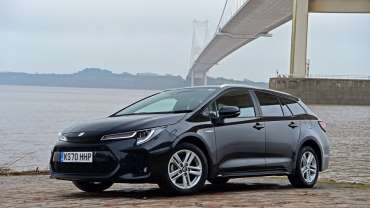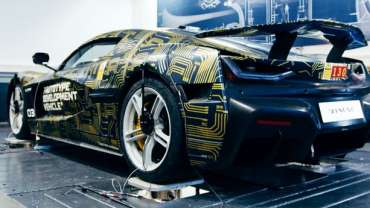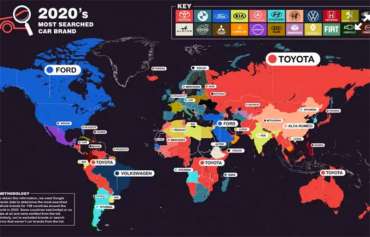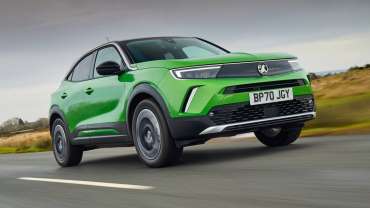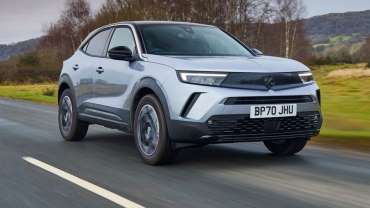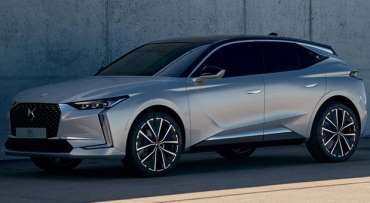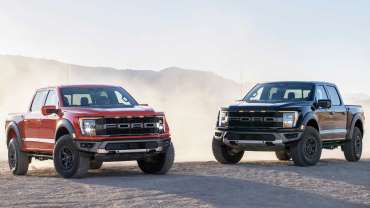
Worldcarblog.com
New Suzuki Swace 2021 review
Japanese maker rejoins the family car market with the badge-engineered Suzuki Swace estate
As with the Toyota Corolla Touring Sports on which it’s based, the Suzuki Swace is a comfortable and frugal estate car that’s relaxing to drive. The Swace does without some of the Corolla’s more luxurious features, but it only offers a minimal financial saving for the sacrifice. Drive a hard bargain at a Suzuki dealer, and the Swace could still be a worthwhile purchase.
If you think the Suzuki Swace looks strangely familiar, you’d be right. Apart from the Suzuki badging, this new estate is virtually identical to the Toyota Corolla Touring Sports.
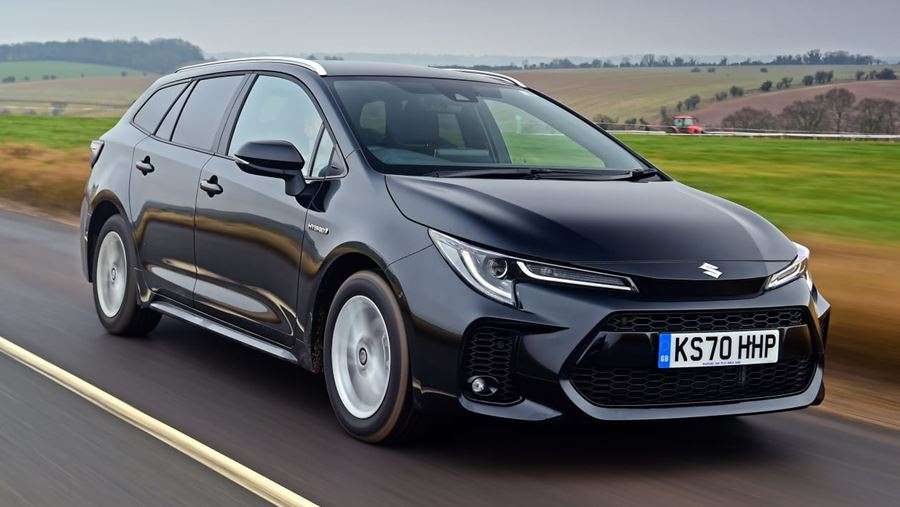
The Swace is the second Suzuki to copy Toyota’s homework (the first was the Across plug-in SUV) as part of an alliance between the two brands. The partnership should let Toyota benefit from Suzuki’s small-car know-how, while Suzuki gets to make use of Toyota’s hybrid tech. To that end, the Swace is even built in the UK on the same production line as the Corolla.
Cosmetically, what little has changed is mainly at the front: the tweaked bumper gets new grilles and a repositioned logo. Less effort has gone into hiding the car’s origins elsewhere. The hybrid badges on the doors are in Toyota’s typeface, while the Suzuki logo on the boot looks like it’s been glued straight over the top of the Toyota badge. Branded centre caps aside, the standard 16-inch alloy wheels fitted to both Swace trims are the same as those used by the entry-level Corolla Icon.
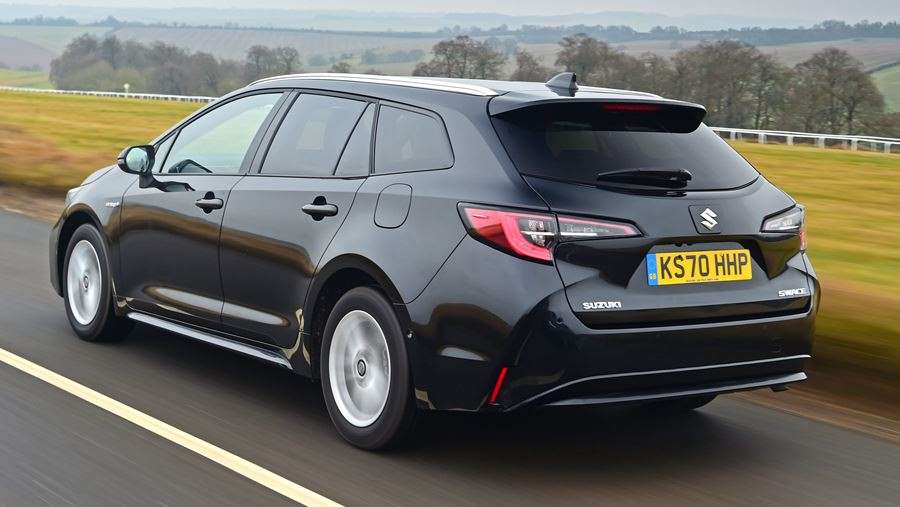
Inside it’s much the same, too. That’s no bad thing, because the cabin is well built, comfortable and roomy. A Skoda Octavia has the edge for space and quality, though.
Suzuki is only offering the Corolla’s smaller 1.8-litre hybrid set-up in the Swace. The petrol engine makes 101bhp and 142Nm, while the 71bhp/163Nm electric motor either operates alone for short distances or assists the combustion engine for a combined output of 120bhp. Drive is sent to the front wheels through a CVT gearbox.
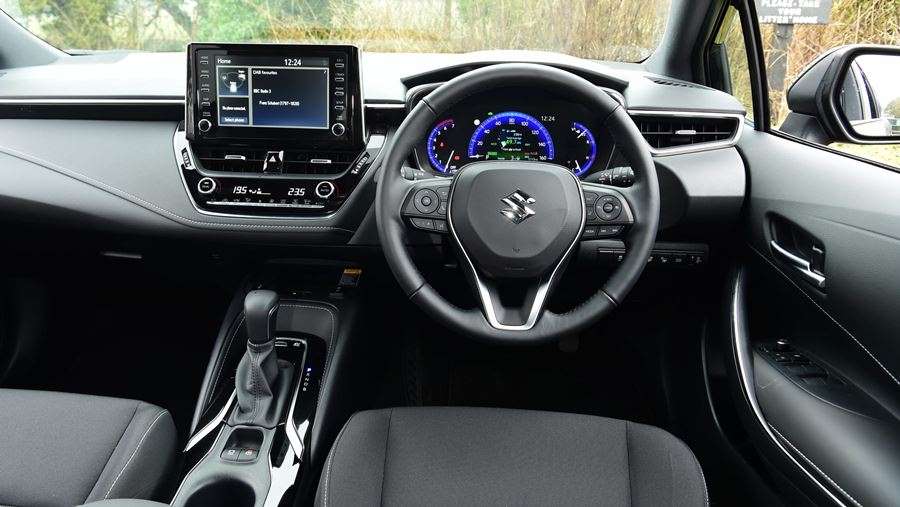
It’s a unit that does its best work in town, where a mix of light acceleration and gentle deceleration using the regenerative braking allows plenty of urban mileage to be covered in all-electric mode. It’s not unreasonable to at the very least match Suzuki’s official 64.2mpg figure in such areas. If there’s enough charge in the battery, it’s possible to select full EV mode – although once the tiny range is exhausted the petrol unit hums back into life.
At higher speeds, the engine starts to let the side down. Despite the electric boost, it never feels that strong, and hard acceleration causes an unpleasant drone as the CVT gearbox holds the revs at the four-cylinder unit’s 5,200rpm peak output. This aside, the Swace drives sweetly. It’s not fun by any stretch, but it handles tidily and rides smoothly – no doubt helped by the chunky sidewalls of those tyres around 16-inch rims.
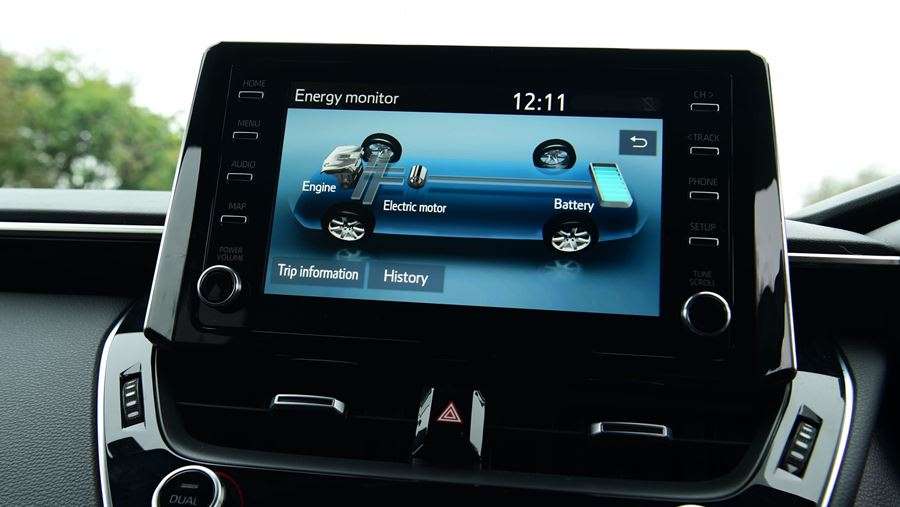
The Swace is offered in two trim levels: SZ-T and SZ5. The SZ-T kicks the range off from £27,499, and gets a long kit list that includes LED headlights, heated front seats and steering wheel, a reversing camera, traffic-sign assist and adaptive cruise control.
The SZ5 costs £29,299. It adds blind-spot monitoring and rear cross-traffic alert, plus parking sensors all round, intelligent park assist, wireless smartphone charging and upgraded LED lights.
In terms of spec, these two models rank closely with high-grade versions of the Corolla Touring Sports line-up, although they do without some of the fancy trinkets available to Toyota buyers. Neither version, for example, gets built-in satellite navigation, although the eight-inch touchscreen features Apple CarPlay and Android Auto in both trims.
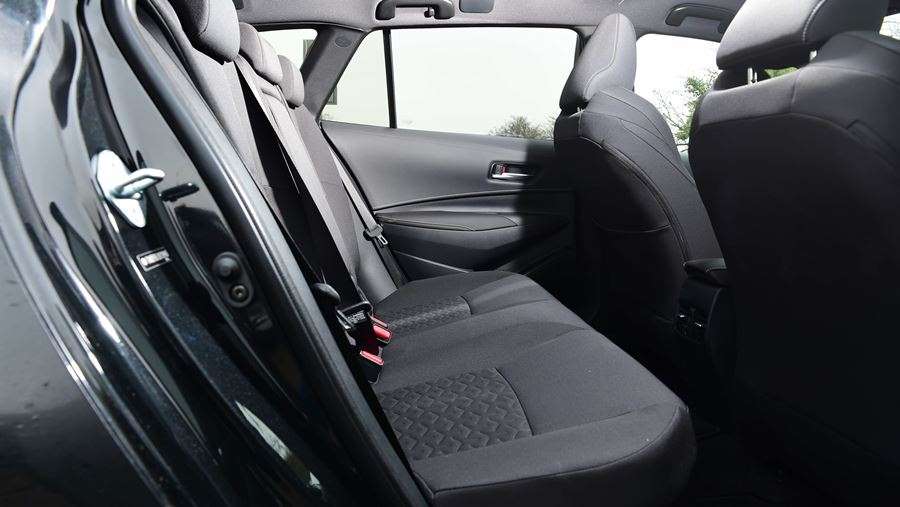
The SZ5 is closely matched to the top-spec Corolla Excel, but does without leather trim and has 16-inch alloys instead of 17-inch items. Not vital of course, but the Toyota is only £711 extra, which isn’t much of a difference.
Then there’s the warranty. All Corolla buyers have the peace of mind of five years or 100,000 miles of cover; the Swace only has a five-year/60,000-mile package for the hybrid tech, and just three years on the rest of the car.
Source: autoexpress.co.uk
Rimac C_Two: Final setting for path and track
The new Rimac C_Two, which is getting closer to series production, proves that a top sports car does not have to be reserved only for the tracks. Proof of this is the final fine-tuning of the suspension, which must behave equally well on the road and on the race track.
According to Vidiauto.com, in cooperation with KW Suspension, the dynamic behavior of the C_Two model is calibrated countless times. It must satisfy many types of surfaces - a perfect race track, open road and highway, and all use special equipment to develop support. This equipment enables computer preparation of virtual surfaces on which the car is driven. Entire paths or certain sections of roads with all the unevenness and other imperfections of the road can be created. Thanks to this KW device and polished by Rimac, the new C_Two is equipped with electronically adjustable shock absorbers and the ability to actively adjust the height of the vehicle, all so that drivers can get the best performance from their future car.
After completing the computer testing and tuning, the C_Two model embarks on a new round of track testing, all to check if the tuning was good enough or not. It will also be the final testing, as the serial version of the C_Two will be introduced in a few months. And Rimac allowed everyone to see how it is done, and you can see the details in the attached video:
{vembed Y=McFqA0bIDNw}
Which car brands are most popular on the internet? What do we search for the most on Google
The Compare the Market website analyzed search data from 158 countries in 2018, 2019 and 2020
Toyota is not only the best-selling car brand in the world, the brand is also the leader in terms of search on Google. BMW, last year’s number one, dropped significantly in this year’s search.
The Compare the Market website analyzed search data from 158 countries in 2018, 2019 and 2020. The total number of car brand searches in 2020 was approximately 88 million. According to the study, Toyota ranked first in 55 countries, representing 34.8 percent of the total number of countries analyzed.
A year earlier, that position was still occupied by BMW, which experienced a huge drop in search volume during the year ravaged by the pandemic. A year earlier, BMW was the most sought-after car brand in 118 countries, compared to only 34 countries in 2020. That represents a drop of 64 percent.
Mercedes-Benz is in third place again this year. Interestingly, the Kia and Ford brands did relatively well, finishing in fourth and fifth place. Both car brands were in last place in 2019, and each was in first place in only one country.
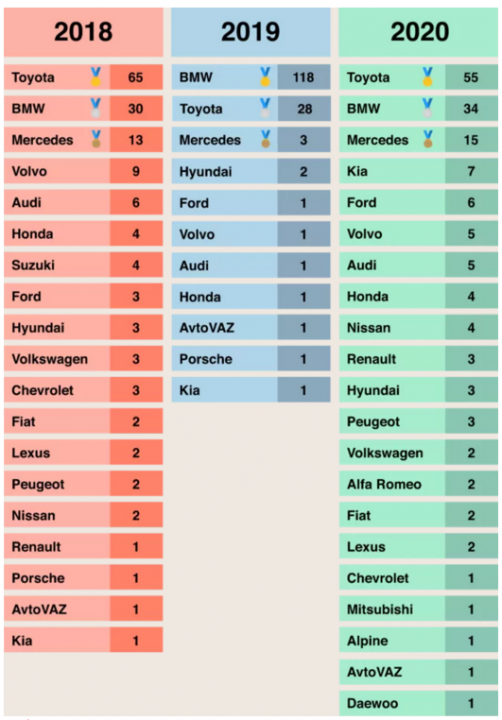
Vauxhall Mokka e (2021) review: green and keen
Not content with just offering combustion engine variants, Vauxhall has released the electric Mokka e version, too.
Still just as stark to look at and with PSA electric tech underneath, it’s already off to a decent start. As for the combustion engine variant, you can read about that one here.
This doesn’t look like a Mokka…
Right? But we promise it is. What a design leap ahead of the Mokka’s desperately dull predecessor.
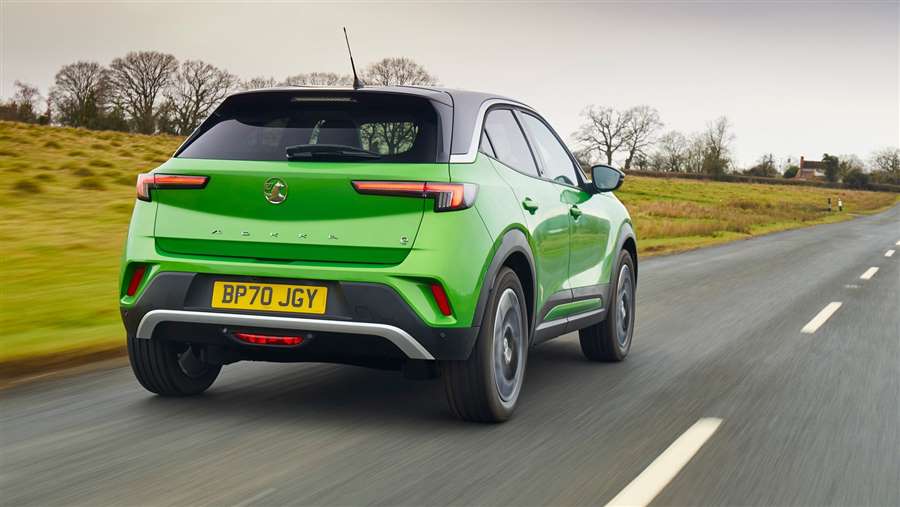
The Mokka is the first car under the Opel/Vauxhall banner to debut a new design language spearheaded by Mark Adams and his team, with the new ‘Vizor’ nose being the starkest visual differentiator. You can spec two-tone colours, with the roof and bonnet available in black and a colour called Mamba Green is available, too – Vauxhall is clearly giving a quiet nod to the Opel Manta GTE here.
Add that to many more angular lines, sharp creases and a floating roofline that’s been par for the course for modern Vauxhalls for years and it all sums up to bringing the new Mokka crossover out of the bland crossover no man’s land.
Inside, it’s much more sensible than its Peugeot cousin, but still a big step forward. Digital instruments – as part of Vauxhall’s new ‘Pure Panel’ nod clean design and some scope for a little colourful personalisation are all on offer here. There’s good adjustment in the seat – though the digital instruments might impede where is best place to put the steering wheel so you see all of the information – and, if you go for a higher trim, the seats have plenty of bolstering to keep you snug.
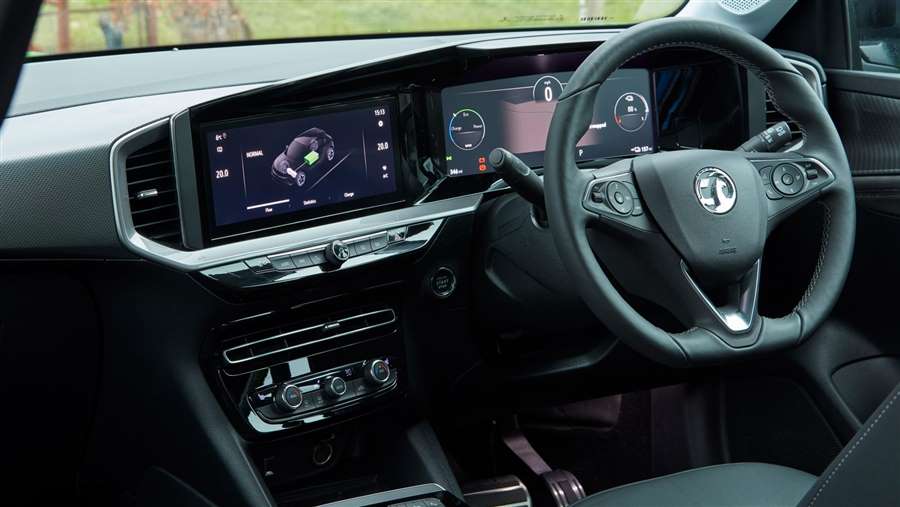
However, the rear seats are best placed for kids only – lanky adults will be jabbing their knees into the back of the seat even if they have plenty of headroom, and the 350-litre boot is around 100 litres smaller than a Ford Puma or Nissan Juke.
Any electric-specific details?
Vauxhall says the Mokka e can support up to 100kW charging capacity, claiming a near empty to 80 per cent charge is done when zapping in energy at that highest capacity. A 50kW rapid charge to a similar state takes a claimed 45 minutes, a 22kW one will take around five hours and a 7kW one is done in around seven and a half hours. Vauxhall claims up to 201 miles of range; during our test we averaged about 3.4 miles per kWh.
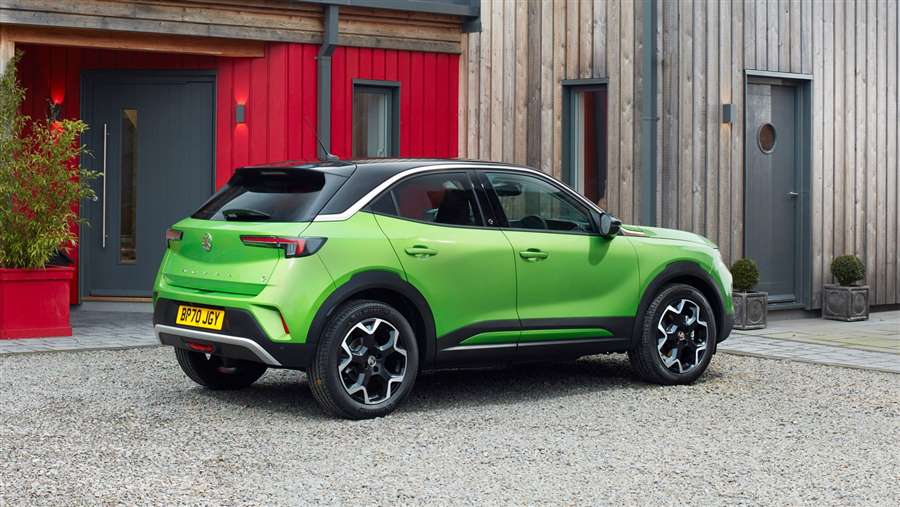
Bespoke Mokka e details are few and far between – as Vauxhall treads the same path as Peugeot in terms of making an electrified powertrain seem normal – so all you’ll notice is a power meter instead of a rev counter on the digital dials, a ‘B’ button next to the shifter for additional brake regeneration and an ‘e’ button underneath the central touchscreen to see energy flow and control when the car charges. Pressing said ‘B’ on the shifter allows harsher, if not quite one-pedal, driving – a boon for driving around town but merely par for the course in terms of EVs right now.
How does the new electric Mokka drive, then?
To say ‘just like an e-2008’ wouldn’t be telling the entire story. Let’s start with the electric powertrain: Stellantis’ (although technically Groupe PSA’s) platform houses a 50kWh battery, with a single 134bhp/192lb ft synchronous electric motor driving the front wheels.
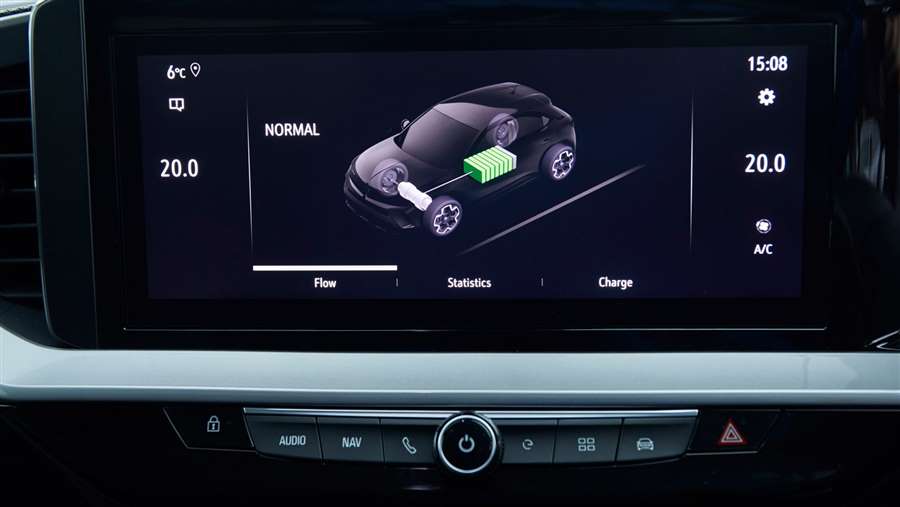
All of that is familiar, with a smooth (if not Ludicrous) surge of torque when you hoof it, gentle regeneration when coasting and a feint whine from the electric motor to go along with your progress. Vauxhall has tweaked how much power is outputted by the motor via the drive modes: in Eco, the throttle mapping is much softer and the motor generates just 80bhp and 133lb ft; Normal ups that to 107bhp and 162lb ft; prodding Sport unleashes all of the shove via a sharper throttle.
As for handling, I’d argue the Mokka e is slightly more comfortable than a combustion engine one – most likely due to the BEV powertrain’s additional weight. It’s impressively well damped and simply not as jittery as our tests with an e-2008 (or even a Puma or Nissan Juke, for that matter), compressing potholes in the road into feeling half their size when driving over them and, given the lack of engine noise, it’s a remarkably hushed experience at the wheel.
Opel/Vauxhall engineers have also clearly tweaked the e-CMP platform and the Mokka’s extensive use of PSA-based controls to their own specifications. The steering isn’t arcade racing game light – like it is in the e-2008 – with a respectable weighting up of the wheel when turning more than a quarter lock and amicable body control. And PSA’s notoriously spongey brake pedal is nowhere to be seen – the Mokka e’s is progressive and bites early. A tidy handler all-round.
Vauxhall Mokka e: verdict
A design revolution outside and an attractive proposition now, too. Granted, it’s not the most practical of small crossovers but, if you’re after a stylish electric runabout for you and your small family, you can now look beyond just Peugeot’s e-2008.
Source: carmagazine.co.uk
Vauxhall Mokka (2021) review: the ultimate glow-up
Your eyes don’t deceive you: this really is the new Vauxhall Mokka. We, frankly, didn’t quite believe Opel/Vauxhall design boss Mark Adams when he said that the GTX Experimental concept was a preview to this all-new crossover, built from the ground up using PSA platforms and technology.
Woah, what a change!
Definitely. Gone is the fuddy-duddy and dumpy looks of the Mokka’s predecessor, replaced with an all new and thoroughly modern look from Mark Adams and Co. The all-new Mokka is the start of a new design language from Vauxhall, with the new ‘Vizor’ front panel on the exterior, chunky wheelarches and sharp lines.

Inside, there’s a design revolution, too – going beyond even the new Corsa in terms of modernisation. It’s all part of Mark’s ‘Pure Panel’ mantra – keeping fuss to a minimum, and designing a dashboard that looks like it flows the digital instruments and central touchscreen in one. Other details include a super-minimalist shifter for the automatic gearbox versions, a lot like VW Group’s efforts with the latest Golf and A3.
Our SRi Nav Premium test car had supportive seats, with thick side bolstering and a kitch pattern on them. There’s ample adjustment in the driver’s seat, with allowance for drivers (like me) to whump it to the floor like a touring car driver. Material quality is good, with chunky indicator stalks and familiar PSA switchgear dotted around. The central touchscreen uses the much maligned PSA software, but arguably seemed to run faster here than previous experiences. Still, the digital instruments (seven inches on lower-end trims, 10 on higher) are clean and easy to digest, and come with varying layouts to suit you.
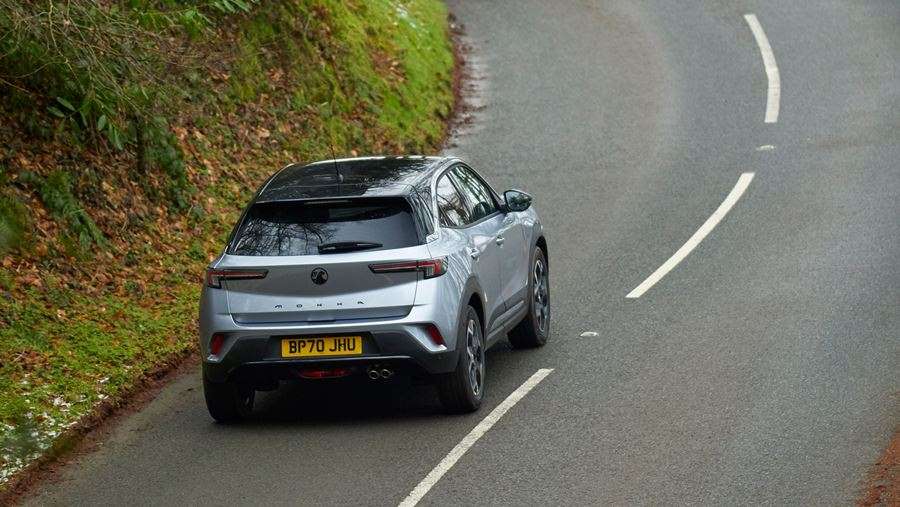
The only fly in the interior ointment is the rear space – tall adults might suffer sitting behind an equally tall driver in terms of legroom, but will have plenty of headroom. Boot space is rated at 350 litres, which is fine and adjusted with a movable boot floor, but the Mokka doesn’t excel here when up against myriad crossover rivals.
What engines can you get?
Vauxhall offers two 1.2-litre turbocharged petrol engines (99bhp and 127bhp – the latter available with an eight-speed auto) and a 1.5-litre diesel. Along with the combustion engine versions, Vauxhall offers the Mokka e, an EV with a 50kWh battery and 134bhp. We tested the 127bhp petrol with an eight-speed auto.
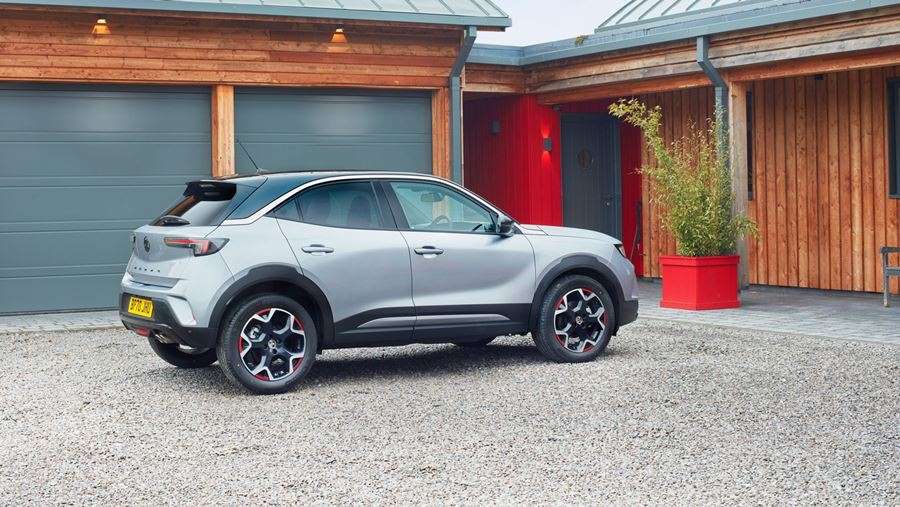
It’s arguably all familiar territory to those who have tried the latest Corsa, or Peugeot’s 208/2008 or Citroen’s C3 and C3 Aircross. The engine has a properly characterful gargly three-cylinder engine note and can get out of its own way, too.
When mated to the eight-speed auto, shifts are smooth in auto and can be controlled by pressing the ‘M’ button on the shifter – the new Mokka comes with wheel-mounted shift paddles. They’re a tad plasticky in feel but they manage not to surprise the auto ‘box when a shift is requested, so there’s little to no lurching when you want a different gear.
What about the Mokka’s handling?
If you’ve not read our Mokka e review already, I’d say that model is fractionally more comfortable in terms of ride quality. There’s an additional softness to the way it rides over lumps and ruts that is missing with the combustion engine Mokka variants. Still, damping is impressive no matter what variant you go for – while it may jitter over lumps a tad more than the Mokka e, the Mokka in general is still a better compromise than the ‘sporty’ Puma and downright irritating Juke.
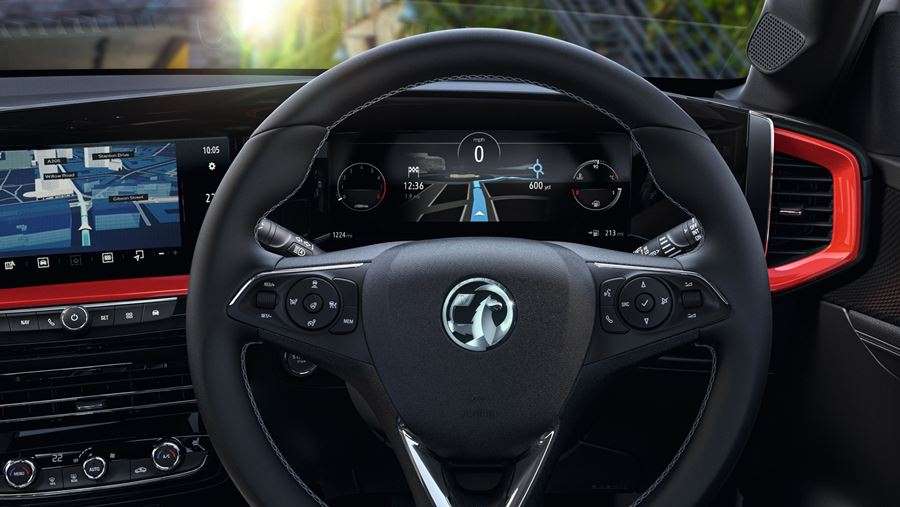
As for overall handling, it’s a sweet blend. Opel/Vauxhall’s engineers have clearly been busy tweaking their own geometry for the steering, adding in welcome weight to the usual PSA’s excessively light steering. It’s the Mokka’s supremely light kerbweight here that does it some favours for keen drivers, with excellent body control and grip available if the moment takes you. Even with the automatic, flicking the drive mode into Sport mode and getting aggressive with your steering inputs… the Mokka is right there with you, ready for action.
Vauxhall Mokka: verdict
Comparing this new Mokka to its predecessor would be a low bar, in reality; the drab looks, dated interior and stodgy drive of the old one is nowhere to be seen here. No, while this new Mokka isn’t perfect – particularly in terms of practicality – we can comfortably say it’s now a small crossover worth looking at. I’d chalk that up as a result for Vauxhall.
Source: carmagazine.co.uk
DS, Lancia and Alfa Romeo will work together to develop a new generation of cars
According to some media, three premium brands in the structure of the new Stellantis group - DS, Lancia and Alfa Romeo, will cooperate in the joint development of the new generation of cars that will be presented in 2024.
DS's product director confirmed that the three brands will receive propulsion systems and technologies that will not be available in other Stellantis models.
"We are working with our Italian colleagues on specific premium models, drives and features to distinguish premium brands from major brands," Marion David told Automotive News.
The models that Lancia, Alfa Romeo and DS have specially planned for the next few years will be developed and offered to the market. The next generation of cars, however, will unleash the full potential for synergy within the newly formed company.
"Cars that are already in development will be launched," says David. "And then for the next generation, we're focused on creating synergies that are the reason for the merger."
The Empire Strikes Back - Ford is the new model F-150 Raptor
While the rest of the world still sees pickup trucks as "prehistoric" work vehicles whose sole purpose is to do work on farms or construction sites, Americans have long found a way to make them civilized enough to be in every garage "across the pond." parked one copy.
The trend actually began in the late 1970s when pickups first received identical equipment from passenger cars, so American buyers quickly realized that they could use such vehicles for transportation to the office on weekdays and then for small chores around the house or weekend fun.
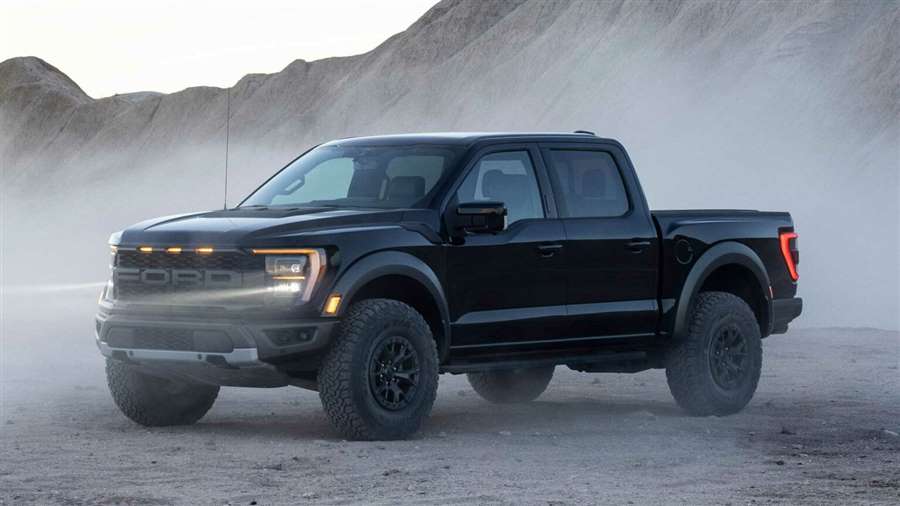
During the nineties, the trend spread to high-performance street racers, but no one dared to make an extreme SUV that will be able to compete on the world's largest "off-road" tracks. And then, in 2008, Ford debuted with the release of the Raptor bestseller F-150 and once again changed the way the "Yankees" see pickups.
There really was no such extreme racer in that period, and how good the Raptor is is perhaps best confirmed by the fact that one of the series finished second in the very demanding Baja 1000 race, which is considered the second biggest field competition after the Dakar Rally.
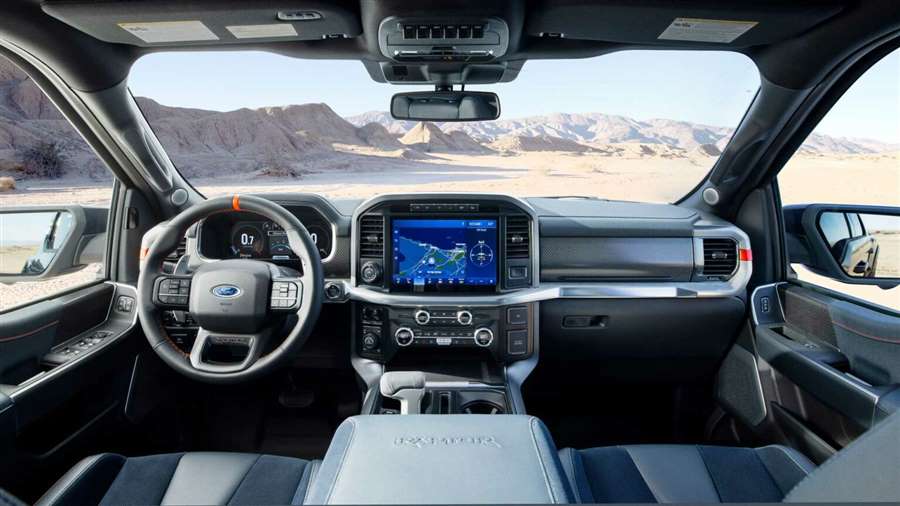
Ford will say it has sold more Raptors in the last twelve years than Chevrolet has delivered units of the Corvette sports model. Although at first glance these two vehicles have nothing in common, their price is almost identical, so they attract customers with an equally deep pocket.
The Raptor also now has competition and a look at the Ram 1500 TRX from Fiat-Chrysler Corporation, whose 702 horsepower looks impressive in addition to Ford's "only" 450 "throats". The second largest American manufacturer is now arriving with the new Raptor and wants to be in the spotlight again.
At first glance, the novelty still doesn’t seem to match the TRX, but Ford assures us that it doesn’t all lie in raw figures such as engine power and acceleration from standstill to 100 km / h in the direction. For starters, the company says that mass is the biggest enemy of high performance, so the solution is not to add strength but to reduce the weight of the truck. And the Raptor definitely delights in that category as it weighs "only" 2,475 kilograms.
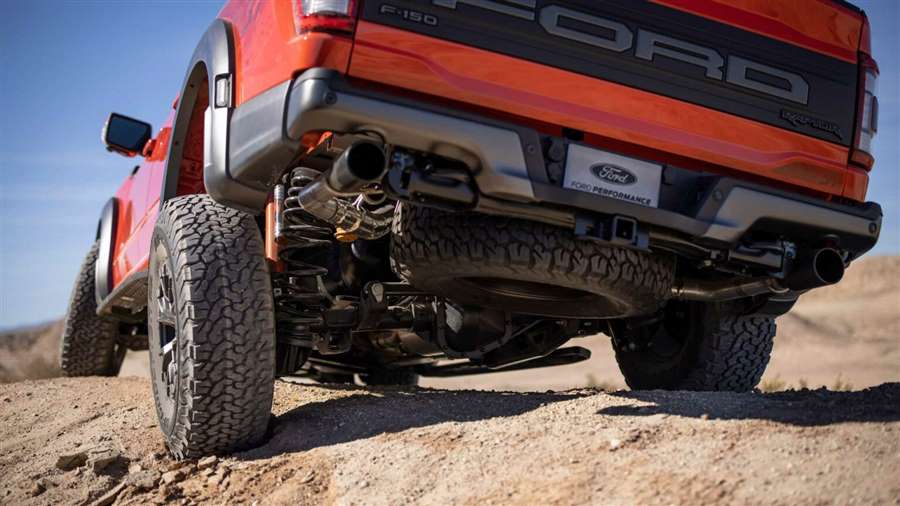
We say "only" because the stated figure is as much as 400 "kilos" lower compared to the Rama thanks to the aluminum construction of the chassis and shell. Perhaps such a figure still seems insignificant, but for vehicles that spend a lot of time "in the air", every gram is worth paying attention to.
The Raptor is not only significantly lighter than the TRX but also dominates in terms of ground clearance. For example, the Raptor boasts 37-inch tires, while those on the TRX are "only" 35-inch. Ford is also better in terms of overall ground clearance (38.1 by 35.5 centimeters) and has developed a suspension to be able to withstand the effort at greater angles. Translated into a simpler language, if you find yourself on difficult terrain from which you need to get out with a slower and planned ride - the Raptor is still the king of its segment.

The category we expected the most detail about is the one where Ford has yet to release information. It is, of course, an engine. The Raptor has in the past provided a 3.5-liter with 450 horsepower, which is significantly less than the 6.2-liter petrol with 702 “heads” in the TRX. Ford has announced to us that the novelty will continue to be available only with a V6 engine, at least initially, but its power is still unknown. It is quite certain that the number will be higher than in the past and we can optimistically hope that it will approach the figure of approximately 500 "horses".
Ford also said that the Raptor R with a V8 engine will arrive next year, and we are quite sure that it is a 5.2-liter model from the Mustang Shelby GT500 with 760 horsepower. In all cases, power is transmitted to all four wheels via a ten-speed automatic transmission.
We will mention another very interesting detail, and that is adjusting the driving style. We have already seen some of the regimes from them, such as Normal and Sport, while Baja serves to storm at high speeds through the desert parts of the American federal states of Arizona or Nevada.
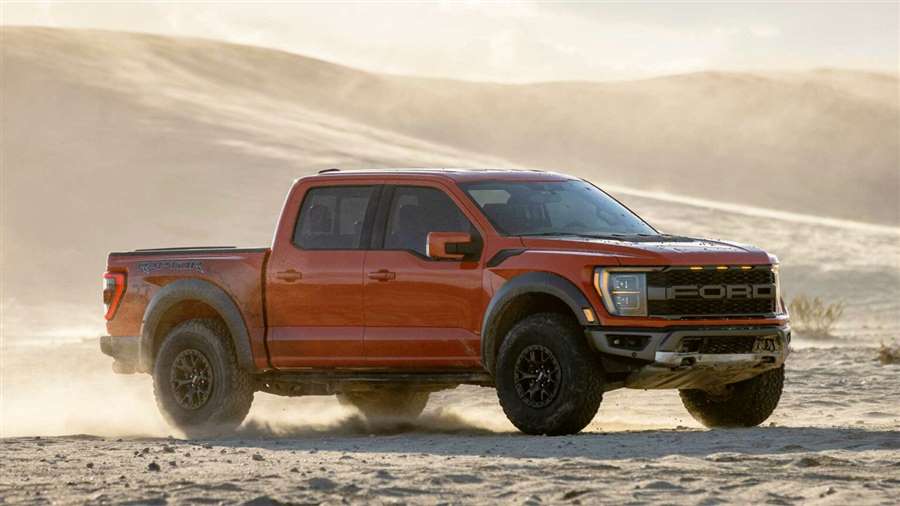
But what is completely new is the so-called "Quiet" regime, or literally "Silence". It allows the Raptor to become even more civilized and not wake up your neighbors if you come home late in the evening or early morning.
The design changes are as we expected. Although the Raptor may look like a standard F-150, the two vehicles actually share only a roof and headlights. Every other stylish part was developed especially for the SUV and we will easily recognize it by aggressive details such as the radiator grille and hood. The interior and equipment have not changed significantly, so we recommend that you read the earlier edition of the new fourteenth generation, where we described in detail what new technology the F-150 brings.
In any case, production will start in the summer, and the new Raptor will arrive in showrooms in October.

